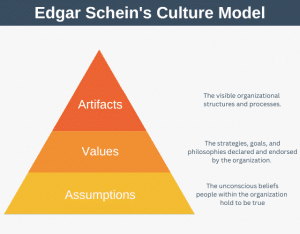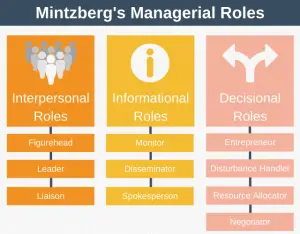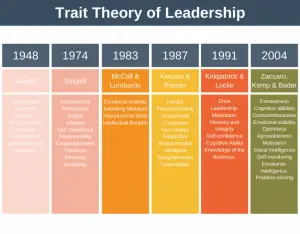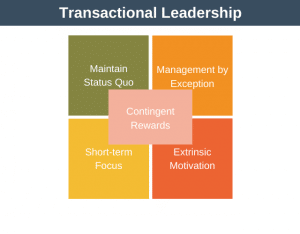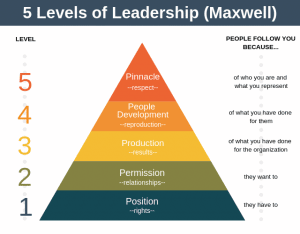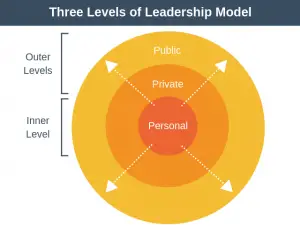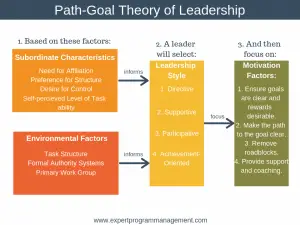Servant Leadership means putting others first, sharing power, helping underperformers to do better, and allowing high-achievers to soar.
Are you the sort of person who asks yourself, “How much money can I make?”, or, “How can I get ahead?”. Or are you more likely to ask yourself, “How can I help all of us to succeed?”. If you’re more likely to ask how you can help everyone to succeed, then you might just be a servant leader.
Servant leadership is the opposite of what we traditionally think of as leadership. All too often we confuse leadership with dictatorship (or autocratic leadership). With servant leadership, instead of the team serving the leader, the top-down hierarchy is turned on its head. With servant leadership, the leader serves the team.
This approach can lead to higher levels of commitment and performance from team members to their work, their team, and their manager.
History
In its modern day form, servant leadership came about in 1970 when Robert K. Greenleaf published his classic essay, The Servant as Leader.
Although modern-day servant leadership came about in 1970, it’s origins go back much further than that.
Laozi, an ancient Chinese philosopher wrote passages describing servant leadership as far back as 500 BC. Servant leadership is also described in many religious texts.
What is Servant Leadership?
A servant leader will be a servant first. They will put the needs of others before themselves, especially their team.
The principles of servant leadership include:
- A desire to serve. The servant leader focuses on what they can do for their people.
- Acknowledging the viewpoints of others.
- Supporting others so they can meet their objectives. This means supporting people to meet their goals both inside and outside of the office.
- Making their team feel like a community.
- Involving others in decision making when it is appropriate.
- Acting with integrity.
These qualities lead to a stronger team with high trust levels, high commitment, and stronger relationships. This, in turn, can lead to higher performance.
“Difficult Decisions
Note that servant leadership isn’t a way to avoid making difficult or unpopular decisions. Sometimes you will need to make an unpopular decision. Sometimes you will need to give a team member negative feedback. The servant leader is able to do this because they always act in the best interest of the team.
Even though the servant leader is giving a difficult message their integrity in doing so means they will maintain trust. They will maintain this trust despite the difficult message they are delivering.
Servant Leadership Characteristics
Many academics have attempted to list the characteristics that best identify a servant leader. Once such list is by Larry Spears, a past president of the Greenleaf Center for Servant Leadership.
Underpinning this list is the desire of the servant leader to serve. That must come first. The list by Larry Spears is as follows:
- Listening.
- Empathy.
- Health.
- Self-Awareness.
- Persuasion.
- Conceptualization.
- Foresight.
- Stewardship.
- Commitment to team growth
- Building community
Let’s examine each in turn.
1. Listening
Servant leadership is about more than just making decisions. Servant leaders must be excellent listeners. Listening is about hearing what individual members of the team are really saying. Then using this information to steer the team towards its objectives.
Listening is about more than what’s being spoken. It’s also about reading between the lines, hearing what’s not being said, and picking up on body-language cues.
2. Empathy
Empathy is closely related to listening. Empathy allows you to put your own views to one side and see the world through the eyes of another. Without an open mind, it is difficult to be empathetic.
3. Health
This characteristic is about supporting each team member both physically as well as mentally. According to Greenleaf, health means making oneself feel “whole”.
From the managers perspective, this means making sure each team member has everything they need to do their job well. This includes support and guidance. It could also mean access to counseling services or a strong health and safety emphasis.
4. Self-Awareness
Self-awareness is about being able to see your own emotions and behaviors and how they affect others. Examining how your behavior affects other might not make you feel great. But, it should prompt you to recalibrate how you do things so you can get better and better at fixing issues more quickly.
Constant self-examination and recalibration of your approach will over time make you a better leader.
5. Persuasion
The servant leader doesn’t need authority to get things done. Instead, they use persuasion rather than formal authority. Where possible, they aim to build consensus around the approach being taken.
Persuasion is an important interpersonal skill which you can learn more about here.
6. Conceptualization
Conceptualization involves looking beyond the day-to-day management of the team. It is about being able to look to the horizon and see the longer-term vision.
In an organizational context, the longer-term vision is often derived from strategic direction of the company.
7. Foresight
Foresight is also about being able to look beyond the day-to-day. It’s about seeing what might go wrong. Seeing issues that might arise in the future and then taking steps where appropriate to mitigate these issues.
It is about scenario planning, risk management, using past experience and the realities of the present to plan for the future as well as is possible. Tools such as SWOT Analysis and PEST Analysis can be useful in providing hints on what might go wrong in the future.
8. Stewardship
Stewardship means accepting that you are responsible for the performance of your team. It also means being the accountable person when your team doesn’t perform.
One common way to motivate your team to perform as a servant leader is to lead by example. This includes modeling both the behaviors and values that you expect others within your team to exhibit.
9. Commitment to team growth
The aim of a servant leader is to grow each employee beyond the ability to simply do their job well. The servant leader should help each team member reach their potential, both personally and professionally.
This, of course, usually means training. But, if you have had to lay people off, it could even mean continuing to support your employees until they have found new employment.
10. Building community
Servant leaders build great team-spirit. A sense of community. A sense of everyone being in it together.
Ways to achieve a real community include:
- Leading with integrity
- Organizing social events and activities outside of the office.
- Practicing Management by Wandering Around (MBWA).
Servant Leadership Examples
Some examples of famous servant leaders include Abraham Lincon, Mother Teresa, and Martin Luther King.
Some companies even try to embed servant leadership into their values. One such example is Southwest Airlines. Most companies have something in their values along the lines of, “treat everyone with courtesy.”. Southwest went one step further, wording their value, “a servant’s heart”. This is a clear attempt to motivate the servant mentality and grow servant leaders throughout the organization.
Servant Leadership and Other Leadership Styles
Note that servant leadership is more of a way of being rather than a style of leadership.
It obviously has nothing in common with autocratic leadership but it does work well with democratic leadership and transformational leadership styles.
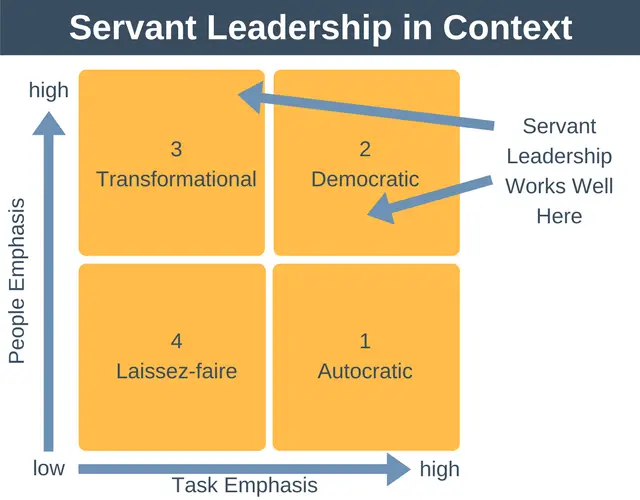
As you can see from the diagram, both of these styles have a real people focus.
You do not need to hold formal power, or be the boss, to be a servant leader. You can behave as a servant leader whilst being part of a team. By doing so you will build what is known as your referent power.
Servant Leadership Summary
Servant leadership is the opposite of what we traditionally think of as leadership. Servant leadership begins with the desire to help others.
It isn’t a leadership style per say, but it can work well with people focused leadership styles, such as democratic leadership and transformational leadership.

